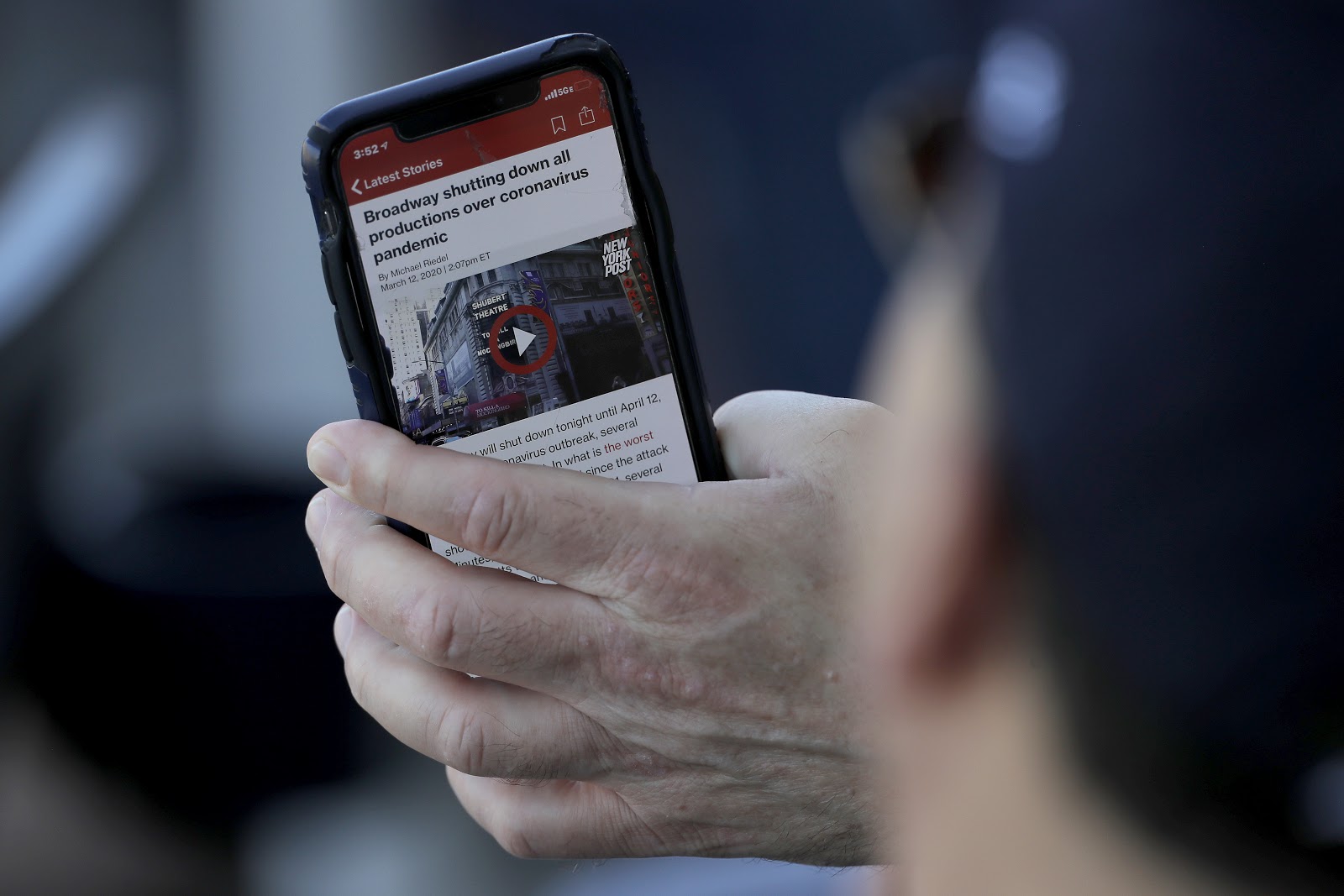The Poynter Report is our daily media newsletter. To have it delivered to your inbox Monday-Friday, click here.
Over the past few weeks, many newspapers and other news websites have taken down paywalls for stories related to the coronavirus.
It’s time to scrap that idea.
Yes, the public is craving information. And, yes, the information provided by journalists is important. But this is suddenly a dicey time for many in the media.
Newspapers in particular are taking a huge financial hit because of rapidly dwindling advertising revenue caused by coronavirus uncertainty. Papers throughout the country are cutting staff, slashing salaries and forcing furloughs just to keep from going under. It’s getting so perilously close to that point that some newspapers are wondering if they can survive much longer — and that means they won’t be able to provide any coverage at all, free or otherwise.
One big media company is already reversing course. Axios’ Sara Fischer first reported that the McClatchy chain will return a paywall to certain coronavirus stories. Major breaking news that impacts the health and safety of readers will remain free, but other stories will move behind paywalls. Which ones will be determined at the local level by the editors at each of McClatchy’s 30 publications.
The reason is simple. McClatchy’s vice president of news, Kristin Roberts, told Fischer, “With a lower paywall, we’re missing opportunities to convert drive-by readers into subscribers.”
With the massive coronavirus-related advertising losses, subscriptions are more important than ever.
McClatchy filed for Chapter 11 bankruptcy in February, seeking relief from an unmanageable debt burden. There has been some good news since then. In a memo to staff, Roberts said the company has gained 10,200 new subscriptions in March, even with no paywalls. And subscriber pageviews are up nearly 50%.
“Since our coronavirus coverage began, 13% of views were by people who would have been stopped by the paywall if it had been up,” Roberts wrote to staff. “If we converted even a tiny fraction of those people, we would have generated more in subscription revenue than we are earning on the per-pageview (‘programmatic’) revenue.”
Roberts also told staff, “Our work — our reporting, our editing, our visual storytelling, our efforts to grow audience, to respond to customer needs, to build new platforms, to send newsletters, to print papers, to create podcasts, to launch digital tools for our readers — is expensive. And it must be supported to ensure that we can continue to inform our communities.”
Last week, Poynter’s Kelly McBride and Rick Edmonds debated whether news sites have an ethical duty to provide coronavirus coverage for free. My initial reaction was to side with making such coverage free, and that it perhaps would lead readers to support that valuable journalism by subscribing.
But everything about the coronavirus story, including the devastating economic impact it’s having on businesses such as newspapers, is changing by the minute. Attitudes about dropping paywalls should change with it.
More trouble
Another day, another batch of grim journalism news. More layoffs and cuts and furloughs are hitting the newspaper industry.
The big one Tuesday was Lee Enterprises, which owns newspapers in 25 states, including the St. Louis Post-Dispatch, The Buffalo News and Tulsa World. Lee announced that the executive team will take a 20% pay cut in the third quarter of this year (on top of a pay reduction in the first quarter), while all other employees will either see a reduction in pay or a furlough equivalent to two weeks of salary. Poynter’s Kristen Hare has more of the details, including a statement from Lee president and CEO Kevin Mowbray.
The Post-Dispatch reported Tuesday that Jeff Gordon, president of the United Media Guild (a local union within the NewsGuild-Communication Workers of America), is negotiating with management about furloughs, but sees them as preferable to layoffs. Gordon, also having such similar discussions with Gannett, understands the gravity of the situation.
“The numbers we’ve heard about ad revenue loss are pretty staggering,” Gordon said.
Be smart about it
As I wrote in Tuesday’s Poynter Report, don’t be surprised to see more papers cut back on their print product during the coronavirus crisis, just as the Tampa Bay Times announced that it will print only on Wednesdays and Sundays for the time being starting next week. As I also mentioned, this could be the push that some papers and, more importantly, readers need to embrace the digital product.
But Kenneth Goldstein, who is president of Communications Management in Canada and also studies media economics and trends, told me, “Newspapers have to re-think the model from top to bottom, and become ‘smartphone first’ — and that does not mean the same thing as ‘digital first,’ which has usually meant simply throwing a print-conceived content package into the online world.”
[the_ad id=”667872″]
Changing on the fly
Life was relatively normal not all that long ago. In that life, some magazines were about to go to print, writing about things that magazines write about. Then the coronavirus pandemic story exploded. The many magazines that were only days away from going to press had to suddenly slam on the brakes and completely change issues.
Take Texas Monthly. The May issue was supposed to have a cover about fishing — a package that had been in the works for months. But on March 20, just two weeks before going to print, the magazine knew major changes were needed.
“These late changes are hard to pull off, especially for our art department, fact-checkers and copy editors, and especially with everyone working from home,” Texas Monthly editor-in-chief Dan Goodgame told me. “But we’ve got a talented, hard-working staff, and we’re confident we’ll get on press, as we must, by Thursday night.”
The cover story now will be on what Goodgame calls a “double whammy” for Texas: the suffering from coronavirus and the collapse of oil prices.
The May issue will still include non-coronavirus coverage, including a profile of Paulette Jiles, a best-selling Texas-based author, and that fishing package. But the magazine won’t look out of place because it will have the story that has taken over the world.
“Our cover story will explore how the pandemic keeps outrunning the slow reactions of most public officials in Texas,” Goodgame said. “We’ve assigned photographers around the state to shoot iconic locations like the Alamo and Fort Worth stockyards that now look like ghost towns. We’ll have other stories on Texas’ key role in the search for a vaccine, and on how to hunker down at home with our favorite Texas-flavored books and movies and music and recipes.”
All this has happened while Texas Monthly continued covering the coronavirus on its website — something made easier by a 50% increase in editorial staff over the past nine months.
“We’ve heard from readers,” Goodgame said, “and noticed from their activity on our website, that they still want a balanced diet that includes entertaining stories about happier topics.”
For some magazines, which need more lead time, it is too late. You will see in the coming weeks as certain magazines hit newsstands that some couldn’t switch in time. Meantime, The New Yorker benefitted from good timing as its annual Health Issue arrives in the midst of the coronavirus.
Fox News sets record
Never have more people watched Fox News than right now. The first quarter of 2020, according to Nielsen, delivered the network’s largest audiences in total day and primetime. These are the highest numbers the networks have seen, passing the first quarter of 2017 (when Donald Trump took over as president) and the fourth quarter of 2016 (when Trump was elected).
For the total day, Fox News was averaging 1.930 million viewers. Primetime drew 3.387 million. The top five cable news network shows also were all Fox News shows: “Hannity” (4.22 million), “Tucker Carlson Tonight” (4 million), “The Five” (3.558 million), “The Ingraham Angle” (3.551 million) and “Special Report with Bret Baier” (3.12 million).
“Meet the Press” has big numbers, too
Last Sunday’s “Meet the Press,” which focused on the coronavirus pandemic, continues to have its best viewership in 15 years. That has been true for the past three weeks. Last Sunday’s show averaged 4.820 million viewers, just 179,000 more than CBS’s “Face the Nation” and 668,000 more than ABC’s “This Week.” An additional 1.201 million watched rebroadcasts on NBC and MSNBC.
The show’s guests were Democratic presidential hopeful Joe Biden, Dr. Deborah Birx, Gov. John Bel Edwards of Louisiana and Gov. Gretchen Whitmer of Michigan.
Listen up
Nicholas Quah’s newsletter about podcasts for Nieman Lab (always an insightful read) uncovered some interesting numbers about podcasts during the coronavirus pandemic. The fact that people are staying at home has NOT been good for the podcasting business. Quoting from Podtrac, Quah noted that podcast downloads have dropped each of the past three weeks — from 1% to 2% to 4%.
The data shows that podcasts about technology, history and true crime have seen declines. Meanwhile, some podcasts are up, such as fiction (19%), business (10%), science (9%) and kids/family (9%). Quah points out that fiction podcasts had seen significant drops since the start of the year until the pandemic set in.
“So, where are we?” Quah wrote. “Though it might still be relatively early, it’s safe to say that podcasting is taking a noticeable hit in the aggregate amid the coronavirus crisis and the behavioral changes it has prompted.”
[the_ad id=”667878″]
Media notes
- ESPN is moving up its 10-part documentary about Michael Jordan’s last season with the Chicago Bulls after all. “The Last Dance” will premiere with parts one and two on April 19 at 9 p.m. Eastern. The documentary will then air two parts each for the following four Sundays, also starting at 9 p.m.
- CNN’s Chris Cuomo has tested positive for the coronavirus. “I will do my shows from here,” Cuomo said in a statement, referring to his home. “We will all beat this thing by being smart and tough and united.”
- After President Trump told “PBS NewsHour” White House correspondent Yamiche Alcindor that she was “nasty” at a recent press conference, and then criticized her again in a news conference earlier this week, the National Association of Black Journalists and Journalism & Women Symposium put out a statement supporting Alcindor.
Hot type
- Exceptional work from The New York Times’ Emma Cott, Ben Laffin and Elie Khadra with this video of “Low Pay, High Risk: Nursing Home Workers Confront Coronavirus Dilemma.”
- A Tampa pastor ignored government “stay-at-home” orders and presided over two large Sunday services. Now he has been arrested, reports the Tampa Bay Times’ Tony Marrero.
- Earlier this week, new New York Times media writer Ben Smith wrote the time has come to let newspaper chains die so we can make way for a future of digital and mostly nonprofit news organizations. Poynter media business analyst Rick Edmonds disagrees — strongly — in this Dear Ben column.
Have feedback or a tip? Email Poynter senior media writer Tom Jones at tjones@poynter.org.
More resources for journalists
- PolitiFact fact-checks about the coronavirus
- Poynter’s News University — Free virtual training
- Fighting for open records during the COVID-19 crisis: April 1at 2:00 p.m. — IRE and Reporters Committee for Freedom of the Press
- Resilience and Self-Care: April 7 at 8:00 p.m. — National Association for Hispanic Journalists
Want to get this briefing in your inbox? Sign up here.











